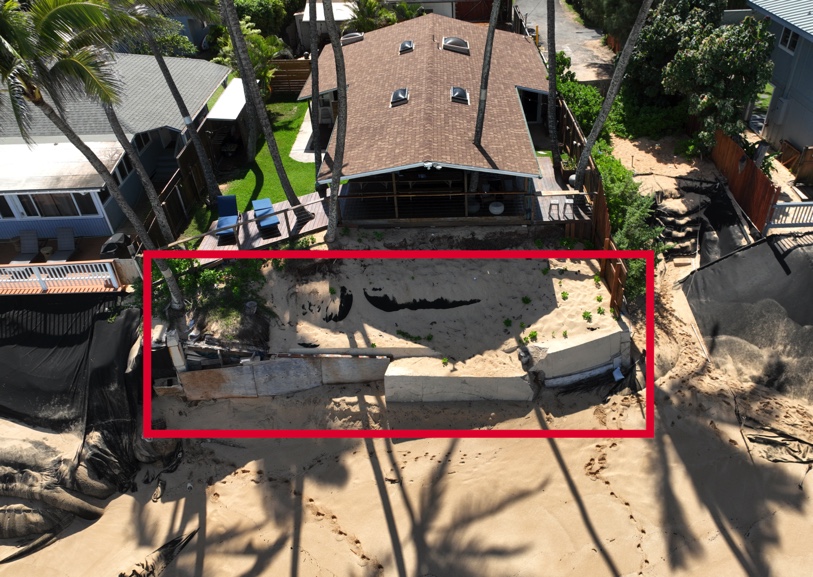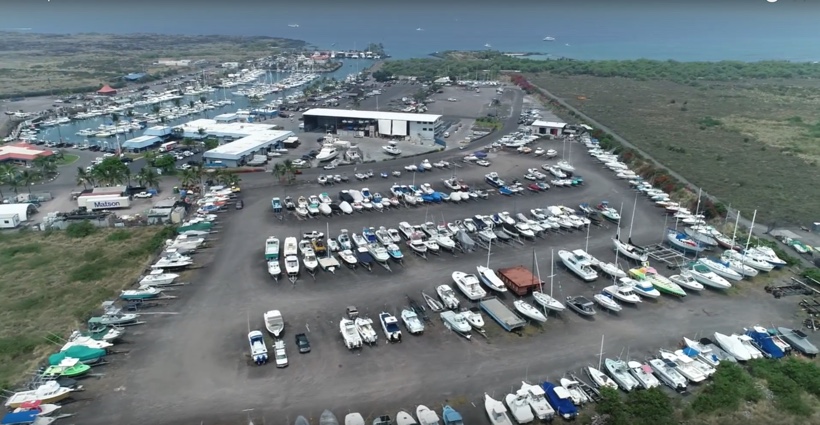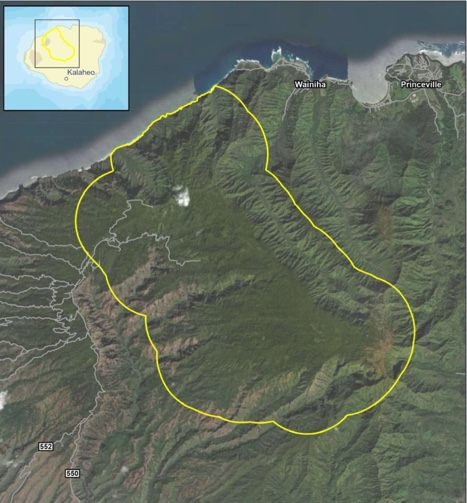Boatyard Manager Seeks Contested Case Over Bond Requirement of Nearly $1 Million
The state Board of Land and Natural Resources had little sympathy for Jonas Ikaika Solliday, whose company is required under its lease to post a performance bond equal to twice the annual rent. It’s a standard condition in state leases, and in Solliday’s case, it would mean he would have to come up with a bond of $846,000.
But as his attorney, Bernard Bays, told the board at its September 22 meeting, circumstances surrounding the issuance and management of that lease have been anything but standard.
In 2018, Solliday and his former partner, Jason Hoʻopai, were the only bidders on a lease for the boat storage yard at Honokohau Harbor that had an extremely high upset rent of $35,250 a month.
Bays alleged that the Department of Land and Natural Resources’ Division of Boating and Ocean Recreation had set the minimum rent that high so as to discourage anyone from bidding, thereby allowing the longtime tenant, GKM, to continue its operations on the lot via a revocable permit.
But that didn’t happen. Solliday’s and Hoʻopai’s company, Pacific Marine Partners, bid on the lease despite GKM prohibiting them from inspecting the property beforehand.
According to a September 14 letter Bays sent to state deputy attorney general Matthew Dvonch, GKM blocked the men from entering the premises until November 2018, months after the lease had been signed.
And when they finally had a chance to tour the property, they found it in shambles: utilities were damaged, the land wasn’t fenced, it had a broken front gate and contained an illegal cesspool, and there was an illegal subtenant occupying a large section of the property.
When the company fell behind on its rent, the state, after first canceling the 10-year lease, decided in July 2020 to rescind that decision and enter into a settlement of around $424,000 over the alleged problems within the lease area.
In the meantime, Solliday and Hoʻopai fought over their respective ownership interests in the company, with Solliday ultimately securing a court decision confirming that he was not a minority owner, but was an equal partner. That prompted Hoʻopai to leave the company and DOBOR to bring to the Land Board in September a recommendation that it assign to Solliday the 50 percent interest in PMP held by Hoʻopai’s company (International and Pacific Enterprises, LLC).
Although the performance bond covering twice the annual rent had always been requirement of the lease, PMP had never posted it. So in its submittal to the Land Board, DOBOR recommended that the board approve the ownership transfer, subject to the posting of a surety bond or irrevocable line of credit of $846,000.
DOBOR property manager Richard Howard told the board that if a tenant has difficulty securing a bond, it can deposit two years of rent as security or provide DOBOR with a standby letter of credit from their bank.
Howard noted that except for the lack of a performance bond, PMP under Solliday’s management had been making timely rent payments.
PMP attorney Bays pointed out that the company’s lease rent is the second highest in DOBOR’s entire system. Although traditionally, bond companies require only a percentage of the bond amount in cash, Bays said that one bonding company said it wanted 100 to 120 percent of the bond amount. A letter of credit from the bank would also require PMP to put up the full bond amount, he added.
“As a practical matter, everybody knew PMP they could not post that amount,” Bays said. He added that the company has posted two months’ rent, which is also a standard amount for some state leases, and has performed all of its other lease obligations.
Bays also noted that DOBOR was treating Solliday differently that it did Hoʻopai, who in October 2019 sought and received a DOBOR recommendation and Land Board approval to assign the lease to him alone, without posting the bond.
“It turned out that application was entirely fraudulent and approval had to be rescinded,” Bays said.
He argued against requiring PMP to post such a large bond now. “This would be like getting a divorce with your spouse when things are going great because you might get a divorce,” he said.
He also argued that in the July 2020 settlement with PMP provided that the state would “take no action to cancel lease for failure to post the bond.” In effect, the settlement constituted a waiver of the bond, he said.
Bays added that the lease itself gives the board the authority to waive the bond if there’s been substantial performance by the lessee.
“I think the board’s approval of the waiver in 2020 was appropriate. The board’s continued waiver of the bond requirement is appropriate today,” he said.
“To sum it up, imposition of the bond today against this lessee would result in termination of the lease, which makes no sense for any of the three stakeholders involved in this. It definitely makes no sense for the state of Hawaiʻi, which has been receiving one of the highest lease rents,” he said. He noted later that the rent for the lease next door to PMP’s is only $7,500 a year.
He noted that PMP has increased the storage capacity at the yard from 275 boats to 360. Although DOBOR did not bring the matter to the board that day, Bays said PMP wants to extend its lease by 10 years so it can amortize $300,000 in improvements it’s planning to make.
In the end, PMP will have put more than $1 million into improving the property, Bays said.
Land Board member Doreen Canto asked Howard how it was possible that PMP was not allowed to enter the property before bidding on it.
“I wasn’t at DOBOR at that time. … I don’t know if the permittee (GKM) allowed them to look. It was encumbered by an RP [revocable permit] at the time. I don’t know,” Howard replied, noting that deficiencies found on the property later were covered by the settlement.
Board chair Dawn Chang reminded Solliday that he accepted the lease terms and understood there was a performance bond requirement.
Board member Riley Smith asked Howard why, in the years since PMP took control of the property, DOBOR had not required the company to post the bond.
Howard said that’s not entirely true. He said DOBOR did send PMP notices at first, “then all this other stuff broke loose,” regarding the property’s condition. “Following the settlement, we were in the midst of the pandemic. That kind of came into play, too. At that point, my focus was not so much the bond, but making sure they performed under the settlement,” he said.
Smith told Solliday that the cost of a bond is based on a risk assessment. “Your former partner put your bid in [and] you knew the bond was required. At that time, how did you intend to meet terms of the lease?”
Solliday said Hoʻopai was in discussion with former deputy attorney general William Wynhoff at the time over “some discrepancies with lease.”
That did not seem to appease Smith. “One of the purposes of the surety is to ensure all of the requirements of the lease is performed. … There is no assurance to the state you’re going to be able to continue to perform. That’s a concern to me,” he said.
Smith asked Solliday how he could assure the board that he would be able to continue to meet the lease requirements.
Solliday said he has a waiting list of boaters wanting to use the lot because PMP offers cheaper rates in Kona for long-term storage. He added that the property has a manager on site 24 hours a day, 365 days a year.
Land Board chair Dawn Chang asked Howard if the DLNR ever waived the bond requirement.
Howard said it did not, adding later that PMP agreed to take on the property “as is.” “Nobody forced them to bid. They decided to bid,” he said.
Chang added that PMP never asked to cancel the lease.
After an executive session, Bays tried to explain that PMP did not ask to cancel the lease because the settlement resolved the issue of whether the company had to post a bond.
“The settlement agreement stands on its own. It’s subject to interpretation. It is what it is,” Chang replied.
In the end, the board approved a motion by Smith to accept DOBOR’s recommendation. The motion passed, although member Aimee Barnes abstained (she had to step out on a personal matter) and member Kaiwi Yoon voted in opposition.
Bays then asked for a contested case hearing on the bond requirement. “We think that’s inappropriate after five years,” he said.
PMP followed up with the required written petition. According to DLNR staff, the department is still reviewing it.
Board Accepts Final EA For Kauaʻi Mosquito Control
On October 13, the Land Board approved a recommendation by the DLNR’s Division of Forestry and Wildlife to approve a final environmental assessment and authorize the board’s chair to issue a finding of no significant impact for a mosquito-suppression project on Kauaʻi.
The project area covers nearly 60,000 acres, including a number of state parks and reserves, as well as 24,283 acres of private lands in the Kokeʻe and Alakaʻi wilderness areas.
Southern house mosquitoes carrying avian malaria have decimated endangered forest bird populations within the project area. The akikiki population, for example, was down to only five individuals as of the board’s meeting, a level that is considered functionally extinct.
The DLNR, the U.S. Fish and Wildlife Service, The Nature Conservancy, the American Bird Conservancy and others have proposed to flood the project area with male southern house mosquitoes that have been lab-infected with a strain of the Wolbachia bacteria that’s different from the one carried by the wild mosquitoes. Any wild female mosquitoes that mated with the released male mosquitoes would fail to produce viable offspring. As a result, the overall mosquito population would decrease, as would the presence of avian malaria.
The incompatible insect technique (ITT) is “the only way we know how to control the diseases,” DOFAW administrator Dave Smith told the board.
DLNR director and Land Board chair Dawn Chang characterized the plight of the endangered forest birds as an emergency. “We used governor’s emergency proclamations for emergencies. I wonder whether it’s appropriate to use a governor’s emergency proclamation to save endangered birds. It’s a good legal question,” she said.
An ITT project in East Maui has already begun to save the birds there, although a demand by Maui resident Tina Lia and her group, Hawaiʻi Unites, that a full environmental impact statement be prepared is being fought in state court.
Smith said that the mosquitoes released there are “not spreading as far as we thought. [We] may need to get more releases.”
“Your update is making this more urgent,” Chang said.
Smith agreed. “We’re literally finding dead birds on the ground,” he said.
Attorney Mauna Kea Trask, former corporation counsel for Kauaʻi County, testified in favor of the FONSI. He said that while hiking Kukui trail recently, something he hadn’t done in 30 years, “the only birds I heard was helicopters.”
He said the ITT is not genetic engineering or modification, which is something some opponents have alleged it is. “I don’t doubt the sincerity or emotions of [the opponents], but they are not experts. … These birds are gonna die. This is literally the least we can do,” he said.
Lia, testifying in opposition, listed the same arguments she has raised with regard to the East Maui project. She alleged that foreign bacteria will be introduced and that the DLNR was lying about that.
“We demand an EIS,” she said.
Lisa Cali Crampton, project manager of the Kauaʻi forest bird recovery project, however, stressed the need for urgency.
“I have been witness to the demise of these species with my own eyes,” she said. Back in 2010, when she started her position, “we couldn’t catch a mosquito if we wanted to. … Nowadays, no matter where we trap or what month, there are mosquitoes in the Alakai plateau. … I know that this IIT is our best chance,” she said.
The board unanimously approved DOFAW’s recommendations, with Maui member Doreen Canto voting with reservations.
Lia then requested a contested case hearing.
Chang then asked her what her connection to Kauaʻi was.
“I did an outreach event to talk to people about this. … Everything is interconnected. We know this project is intended for all islands. I’m connected to all islands, as all of us are,” Lia replied.
Board Approves Emergency Permit For North Shore Seawall Removal
Last year, the Land Board completed a settlement agreement with Seamaids, LLC (whose members include Brandee and Liam McNamara), over an unauthorized seawall built at the edge of the Sunset Beach home they own.
The Land Board had found in January 2021 that the McNamaras had violated Conservation District rules when they shored up their collapsing seawall with concrete, without any city or state approvals.
The settlement was reached after a they had requested a contested case hearing over the board’s imposition of a $35,000 fine and order to remove the seawall.
The agreement requires the removal of any and all unpermitted shoreline protection devices by the end of this month. The McNamaras would then be allowed to apply for a permit to install emergency erosion control measures, such as sand-filled geotubes (often called “burritos”). The agreement states that a completed application would not be unreasonably denied.
According to a report by the DLNR’s Office of Conservation and Coastal Lands, the McNamaras plan to install six rows of burritos inside a trench at the base of the slope below their home, once the seawall is removed. Each burrito would be 5-6 feet wide and 2-3 feet tall. The tube structure would span 7,000 square feet.

On October 27, the OCCL recommended that the Land Board approve an emergency Conservation District Use Permit for the removal of the concrete wall and installation of the geotube structure. The permit would allow the burritos to remain in place for only one year after the seawall removal. The McNamaras would have to apply for a new permit if they wanted to keep them longer.
The McNamaras would also need to get a right-of-entry permit from the DLNR’s Land Division for the temporary structure.
Based on recommendations from a member of the public, Denise Antolini, the board considered amending the OCCL’s recommendations to include requirements that the McNamaras provide the public with notice of their activities and restore the city right-of-way adjacent to their property in accordance with whatever permit the city issues them.
At the board’s meeting, former DLNR director Peter Young, representing the McNamaras, complained that the Land Board’s decision does not allow the work to proceed, since they still need a right-of-entry permit. Also, given the requirement to comply with a city permit regarding the right-of-way, Young said there was no way the unauthorized shoreline protections could be removed by the end of the year. The city permit alone was expected to take a month to obtain, he said.
Board chair Dawn Chang said that the board could not amend the OCCL’s recommendation that day to extend the removal deadline because it was not on the board’s agenda.
With the understanding that the Land Board could later entertain an extension request, the board approved the OCCL’s recommendations with the amendments regarding public notice and the city right-of-way.
—Teresa Dawson



Leave a Reply